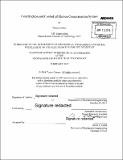Construction and control of motion compensation system
Author(s)
Gomez, Teresa M
DownloadFull printable version (4.442Mb)
Other Contributors
Massachusetts Institute of Technology. Department of Mechanical Engineering.
Advisor
Anuradha Annaswamy.
Terms of use
Metadata
Show full item recordAbstract
The rise of technology has put applications such as video filming into the hands of the everyday consumer. With this has come a proliferation of casual camera hardware and self-filmed video. This project concerns the construction of a motion compensation device to augment the video capabilities of casual hardware. It combines facial recognition and tracking, control algorithms, and linear actuation to enable a screen or other object to adapt real-time to the user's head motion. Unlike other solutions, this system focuses on small, automatic movements based on facial recognition that do not require particularly expensive or specialized equipment to achieve. A webcam is mounted on a moving frame and connected to a primary computer. This device compensates for user motion through physical actuation of this camera, triggered by live analysis of the video feed. The device achieved performance suitable for most envisioned applications. The observed resolution was sufficient to detect and respond to the expected range of movement. Speed and range of motion were adequate for mild motions, though accurate face tracking was maintained only a few minutes. Without large and vigorous movements, uninterrupted operation could be sustained for that length of time.
Description
Thesis: S.M., Massachusetts Institute of Technology, Department of Mechanical Engineering, February 2015. Cataloged from PDF version of thesis. "February 2015." Vita. Includes bibliographical references (pages 53-56).
Date issued
2015Department
Massachusetts Institute of Technology. Department of Mechanical EngineeringPublisher
Massachusetts Institute of Technology
Keywords
Mechanical Engineering.